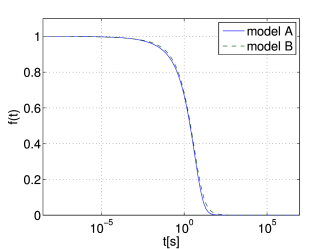6 Representation of the solutions as functions of time
[1287.5.1] In [20]
we obtained the analytical solution of a fractional differential equation
of rational order, which we use to analyze our fitting results
for model A and model B.
[1287.5.2] For a general solution of equations (11) and (12)
with arbitrary real ![]() see [35].
[1287.5.3] The restriction to rational
see [35].
[1287.5.3] The restriction to rational ![]() is not a drawback,
because we can approximate
is not a drawback,
because we can approximate ![]() and
and ![]() by a rational value on a grid between 0 and 1.
[1287.5.4] This number of grid points is chosen to be 20, which keeps computation
times reasonably limited as the computing time increases quadratically
with the lowest common denominator of
by a rational value on a grid between 0 and 1.
[1287.5.4] This number of grid points is chosen to be 20, which keeps computation
times reasonably limited as the computing time increases quadratically
with the lowest common denominator of ![]() with 1.
with 1.
[page 1288, §1]
[1288.1.1] The solution for ![]() for model B is a sum
of Mittag-Leffler type functions:
for model B is a sum
of Mittag-Leffler type functions:
| (14) |
where ![]() is the smallest number for which both
is the smallest number for which both ![]() and
and
![]() are integers.
[1288.1.2] The coefficients
are integers.
[1288.1.2] The coefficients ![]() are the zeros of the characteristic polynomial
are the zeros of the characteristic polynomial
| (15) |
the function ![]() is defined as [36]
is defined as [36]
| (16) |
[1288.1.3] The coefficients ![]() are the solutions of
the linear system of equations
are the solutions of
the linear system of equations
| (17) | ||||
| (18) | ||||
| (19) |
[1288.1.4] This solution is only valid if all the roots ![]() of the characteristic polynomial in (15)
are distinct, which is checked in the computations.
[1288.1.5] Because the linear system of equations (17)-(19) is
underdetermined we choose one fundamental solution for
of the characteristic polynomial in (15)
are distinct, which is checked in the computations.
[1288.1.5] Because the linear system of equations (17)-(19) is
underdetermined we choose one fundamental solution for ![]() and a
multiplication factor for
and a
multiplication factor for ![]() such that
such that ![]() .
.
[page 1289, §1]
[1289.1.1] The analytical solutions are plotted
for glycerol at ![]() (Fig. 7).
[1289.1.2] The fitting values for
(Fig. 7).
[1289.1.2] The fitting values for ![]() for model A are
for model A are ![]() and
and ![]() .
[1289.1.3] Both values lie in the time interval where the relaxation occurs,
which confirms the interpretation of these fitting parameters as relaxation times.
[1289.1.4] For model B the fitted times are
.
[1289.1.3] Both values lie in the time interval where the relaxation occurs,
which confirms the interpretation of these fitting parameters as relaxation times.
[1289.1.4] For model B the fitted times are ![]() and
and ![]() .
[1289.1.5] So
.
[1289.1.5] So ![]() marks the onset of the relaxation and
marks the onset of the relaxation and ![]() the end.
the end.

[1289.2.1] We note that the fractional derivatives appearing in
the initial value problem (7)
can be generalized to fractional derivatives
of arbitrary type ![]() introduced in
[29]
and defined as
introduced in
[29]
and defined as
| (20) |
[1289.2.2] For the case ![]() it reduces to the Riemann-Liouville
fractional derivative, while for
it reduces to the Riemann-Liouville
fractional derivative, while for ![]() to the
Liouville-Caputo-type derivative [33].
[1289.2.3] Because
to the
Liouville-Caputo-type derivative [33].
[1289.2.3] Because
| (21) |
the solution of our initial value problem does not change by replacing
the Riemann-Liouville fractional derivatives with these generalized
Riemann-Liouville fractional derivatives of type ![]() .
.
